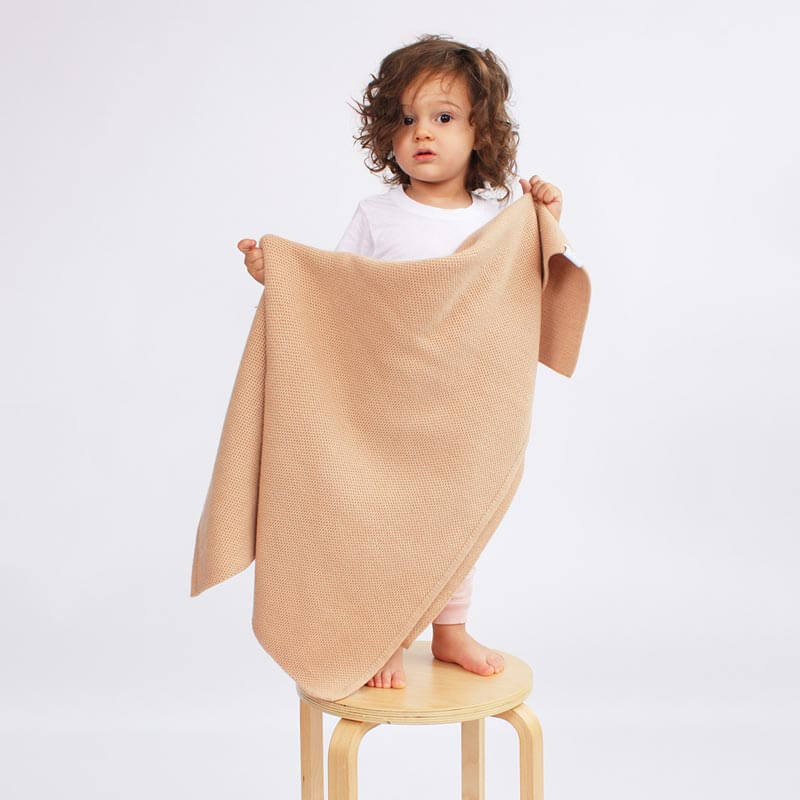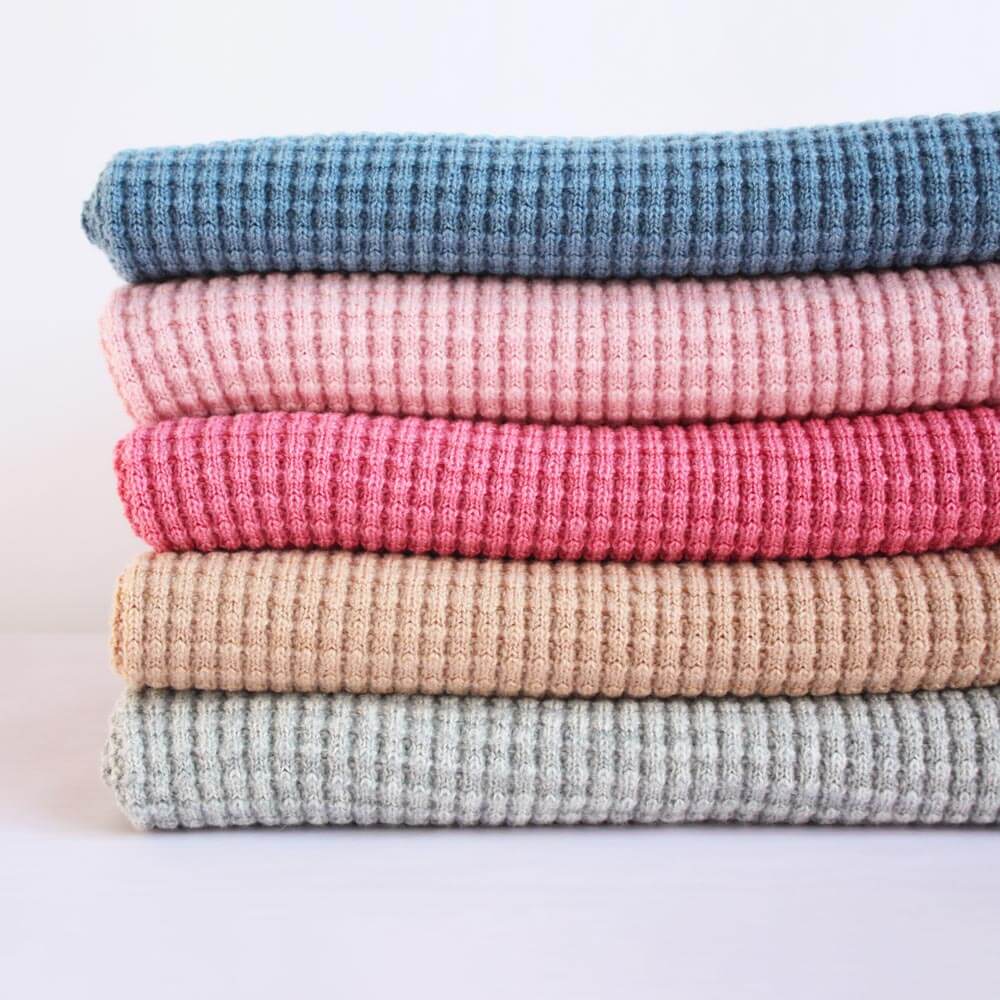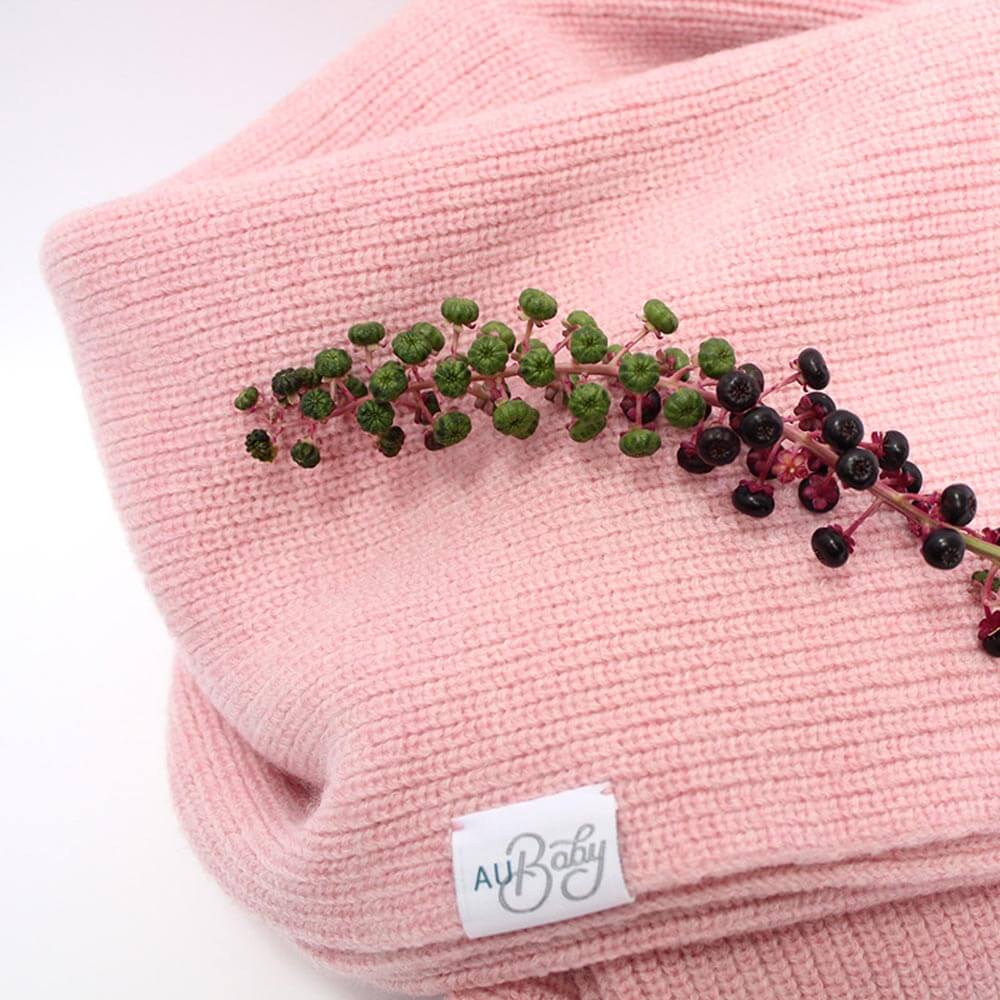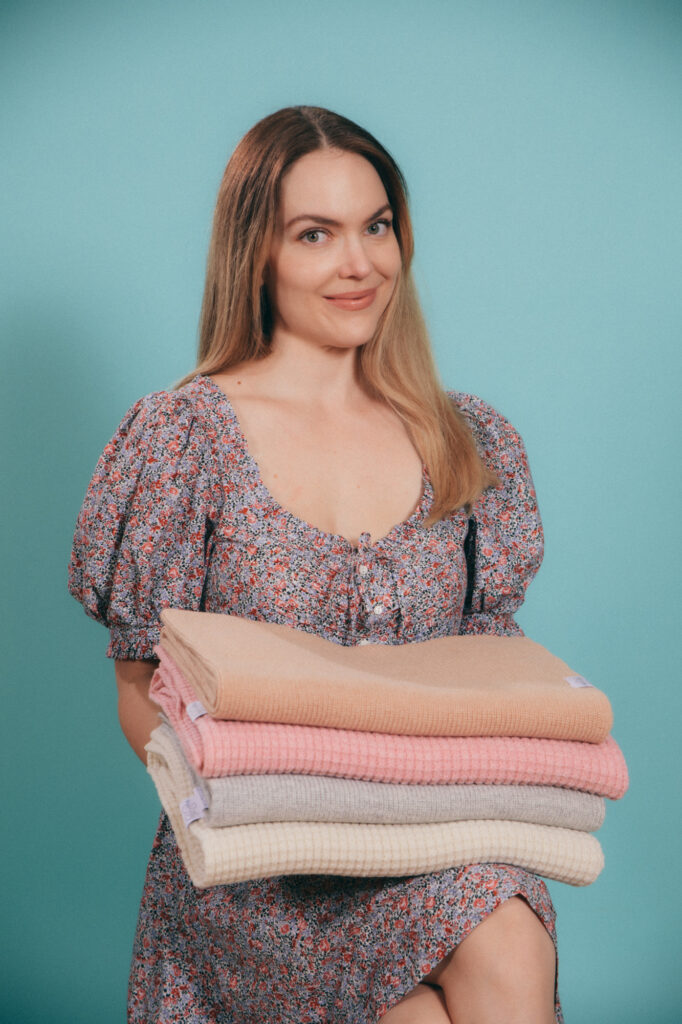Textile production is the world’s second most polluting industry, second to the oil industry, accounting for approximately 1.2 billion tons of greenhouse gas emissions (more than for international flights and maritime shipping combined). For this reason, sustainable knitwear fabrics have become emblematic of a significant shift in the fashion industry, created with environmental preservation and ethical practices in mind.
Natural fibers, a common choice in sustainable knitwear, are biodegradable, reducing fashion’s contribution to landfills; dyed using non-toxic, low-impact dyes with innovative techniques like waterless dyeing, which further minimizes environmental impact by requiring less water and energy in the manufacturing process compared to conventional fabrics. Additionally, most of these materials grow with no pesticide or fertilizer and employ no chemical treatment, thus reducing the overall carbon footprint.
Benefits for Children and Babies
Babies and children explore the world by putting everything in their mouths, so naturally, their clothing endures a lot of wear and tear, but sustainable knitwear fabrics are renowned for their durability, ensuring your child’s clothes last longer. They are also free from harmful chemicals, making them safe, soft, and breathable.
The American Academy of Dermatology estimates that 10 to 20 percent of children in the world have eczema, and it affects up to 20% of infants. With all this information, why are there so many parents who don’t consider investing in hypoallergenic fabrics at home?
High Energy Frequency of Sustainable Fabrics
Beyond sustainability, the high energy frequency of sustainable fabrics can have a positive impact on human well-being. While this concept may be subjective, many who wear sustainable knitwear attest to feeling a deeper connection to nature and an increased sense of harmony.
In 2003, a study was done by a doctor, Heidi Yellen, on the frequencies of the fabric, where the frequency measurements were done in angstroms (m) using a digital instrument called an Ag-Environ machine. According to the machine, the human body has a frequency of 70-100m (in people with illness that drops below 50m). Dr. Yellen’s premise was that any fabric with a higher frequency than that benefits humans, and any fabric with a lower frequency causes or increases illness.
Dr. Yellen’s studies showed that linen and wool, usually more sustainable than man-made fabrics, had a frequency of 5000. While polyester, acrylic, spandex, lycra, viscose, and nylon measured 0. These fabrics are genuinely dreadful for the environment and trap heat (or cold), whereas natural fabrics are thermal regulating and cozy no matter the weather.
Conscious Products for a Conscious You
As a purpose-driven marketing agency, we encourage you to explore the world of sustainable knitwear fabrics and embrace their benefits for your whole family. By choosing clothing that aligns with your values, you not only contribute to a more sustainable fashion industry but also enjoy the comfort, durability, and potential energetic benefits these fabrics offer. Let’s weave sustainability into your wardrobe and make fashion a force for good.
Brands We Love to Love
AU Baby: All-natural, plant-dyed baby blankets.
Use Code CADA15 For 15% OFF
A conversation with Alexandra, Founder of AU Baby
Tell us about your background and the story of AU Baby.
AU Baby was born out of a lifelong career in knitwear design, plus my wellness obsession! Since graduating from Central Saint Martins in 2010, I’ve designed knits for brands like Opening Ceremony, Prabal Gurung, and Nike. My personal wellness journey started with finding foods that worked for me (and identifying a lot that doesn’t!) as well as cleaning up ingredients in my everyday products: makeup, skincare, and cleaning products. Once I realized the huge impact that textiles have on our health, the idea to create the world’s purest baby blanket was born.
We love your functional and sustainable technology made with extra fine Merino, tell us more.
Merino is magical! There are so many benefits built into the fabric, it’s mind boggling. Merino is both luxurious and an everyday workhorse. The beauty of its function is that it’s all engineered by Mother Nature herself – no coatings, no chemicals. Merino’s performance benefits are the product of thousands of years of evolution, born from a need for the sheep to stay cozy and dry while out in the elements. How cool is that! Also, it’s one of the few naturally renewable materials. The merino fleece grows yearly, whether the sheep was shorn or not.
Your blankets are the first to help babies with the 3 S’s: Sleep, Stains and Skincare. Can you break this down for us?
We strongly believe that babies deserve performance fibers – just like athletes, astronauts, and racecar drivers. Why shouldn’t a blanket adapt to keep babies comfortable? After all, they can’t communicate their needs! Maybe it was my time engineering footwear materials for athletes like LeBron James, but I don’t get how the baby blanket, such a key essential item, has gone so long without a reboot.
Our blankets are scientifically proven to help babies fall asleep faster and sleep deeper. This is a function of Merino’s ability to maintain an ambient temperature – not too hot, not too cold. No other material can do that. The same temperature-regulating and sweat-wicking effect that improves sleep quality also benefits the baby’s skin. By absorbing excess moisture and preventing overheating, our blankets prevent common skin issues like eczema. Ready to nerd out even more? Merino is made up of the same protein as our skin. There’s nothing more gentle for a newborn baby.
Now, for the self-cleaning aspect. Babies are messy! Merino solves this by being naturally stain-resistant. Milk spills literally slide right off and can be dabbed clean. I wash my daughter’s blanket once a year, knowing it stays clean down to a fiber level thanks to Merino’s natural microbe resistance.
What advice do you have for moms or dads transitioning their family to a more nontoxic lifestyle?
Take small, manageable steps to avoid burnout and overwhelm. It’s helpful to frame a nontoxic lifestyle in a hierarchy of importance: food, water, skin, home. Start with prioritizing nutrient-dense, unprocessed foods, and good-quality filtered water. Next, look at what’s absorbed into the skin via personal care products and synthetic fabrics. Lastly, decrease your family’s exposure to toxins in the home by removing fragrances and harsh cleaning chemicals. EWG and ThinkDirty are both excellent resources for vetting both skincare and cleaning products. They have apps so you can have all the information at your fingertips wherever you shop.
What are your favorite wellness rituals to help babies sleep well?
Some babies, like mine, were just not good sleepers. First, stop comparing your baby to other babies! Establishing a bedtime routine early creates positive associations with bedtime, even if you don’t reap the rewards for a while. In addition to the usual sleep aids like blackout curtains and a white noise machine, we liked using a red bulb in our nursery at nighttime. It helped my daughter stay in the sleepy zone during late-night diaper changes. Now that she’s 2, we love our nightly ritual, which involves reading three stories and a “goodnight banana.” A full tummy and a tryptophan-boosting snack = win-win!
You are on a mission to clean up the toxic textile industry. What’s next on the horizon for your brand? Any certifications or purpose-driven initiatives?
Most people don’t realize that textile dye is the 2nd largest polluter of waterways worldwide or that polyester is chemically the same as plastic. We are on a mission to make safe, natural alternatives mainstream by not only utilizing Merino, but also our 100% pure plant dye technology. What’s next for us? We are launching our new cashmere blend collection with fresh styles for babies AND adults. Our customers want to cozy up with AU Baby themselves, and we’re making that dream a reality!
As far as certifications go, we’re working to educate consumers about our NATIVA™ and Responsible Wool Standard credentials. We take animal welfare seriously and are proud to offer the highest level of transparency and ethical standards available. Just scan our hang tag’s QR code and follow along on our sustainable wool’s journey from a family farm to our LA-based factory. Happy sheep, happy blankets.





